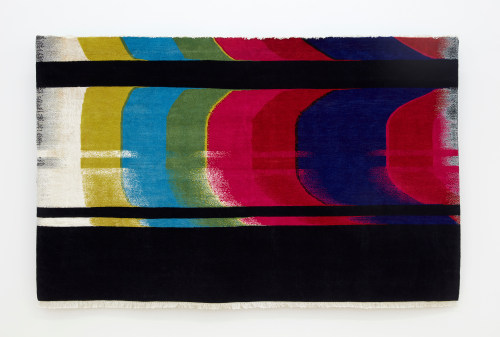
Living with Art: The Changing Landscape
By Ylise Kessler
December 3, 2023
In the world of culture, trends often dominate various domains like fashion, food and design. Art is no exception. Consider the shift from figurative to abstract painting, or the contrasting worlds of conceptual art and socially engaged practices. What may initially appear as a fleeting trend often signifies a significant shift in what the art world values. In these instances, art created by groups of artists whose contributions were previously disregarded or deemed inferior rises to prominence, achieving the recognition it deserves. Is this merely a coincidence? Not at all.
Typically, there is an element of activism involved, compelling the world to take notice. The first marginalized group that comes to mind is art by women. The Guerrilla Girls, an anonymous collective of feminist artists dedicated to combating sexism and racism within the art world, was instrumental. The group’s inception dates back to 1985 in New York City. It followed a protest against the Museum of Modern Art, when it came to light that less than 10% of the museum’s collection featured works by women artists. The journey has been long, but women artists are finally receiving the recognition they deserve through major museum exhibitions and representation in blue-chip galleries. Eminent artists such as Louise Bourgeois, Bridget Riley, Louise Nevelson and Yayoi Kusama are just a few examples of women artists who have garnered international acclaim. Admittedly, the embrace of women artists as formidable contenders primarily began with elderly or deceased women, but progress is being made.
In 2020, the Black Lives Matter movement played a pivotal role in redefining the representation of Black artists in the contemporary art market. Notable artists — such as Kerry James Marshall, Kehinde Wiley, Mark Bradford, Stanley Whitney and Jack Whitten — started receiving invitations to exhibit their works at prestigious institutions. These included the Metropolitan Museum of Art, the Whitney Museum, the de Young Museum, and the Solomon R. Guggenheim Museum. Moreover, Black artists were invited to represent our country in the US Pavilion at the Venice Biennale, an annual international cultural exhibition. In 2023, a substantial number of Black artists, too numerous to list, finally began receiving the recognition and acknowledgment they rightfully deserve.
The art world is now undergoing a transformative phase in which women and artists of color are breaking through the predominantly white, male-dominated contemporary art culture. However, there’s one subgroup that was, until recently, excluded from the conversation: Indigenous artists. Historically confined to regional or ethnographic venues, contemporary Native art was overlooked by the broader contemporary art world. Change began with the emergence of Native curators like Candice Hopkins, of Lingit descent and originally from Whitehorse, Yukon, coming onto the scene. Hopkins has played a significant role, serving as the senior curator for the 2019 and 2022 Toronto Biennial of Art and co-curator for the 2018 SITE Santa Fe Biennial, Casa Tomada. She was also part of the curatorial team for documenta 14 in Athens and Kassel, Germany. In 2023, Hopkins curated Indian Theater: Native Performance, Art, and Self-Determination since 1969 at the Hessel Museum of Art at Bard College. This is only a brief list of major shows that have elevated the global perception of Indigenous art.
One standout Indigenous artist who has repeatedly exhibited in many group and solo shows is Nicholas Galanin (Lingit/Unangaˆx). I first encountered Galanin’s work at the 2019 Whitney Biennial in New York. One of his two featured artworks, White Noise, American Prayer Rug (2018), stood out. This piece portrays a woven image reminiscent of static, or white noise, on a television screen. Its title references the sources of American political power and media that produce constant noise in support of xenophobia. While the artwork itself is remarkable, what truly captured my attention was Galanin’s principled stance. Along with seven other artists in the prestigious exhibition, he withdrew his work in protest of the presence of Warren B. Kanders serving on the Whitney Museum board. Kanders is the owner of Safariland, a company manufacturing tear-gas canisters and other weapons used against protesters worldwide. Here was an artist, relatively lesser-known, residing in Alaska, who sacrificed a significant opportunity for exposure to his work to make a powerful protest. It was a profound moment that garnered attention not only from me but also from the art world at large.
Nicholas Galanin’s exhibition, Interference Patterns, is currently on view at SITE Santa Fe. It is a remarkable solo presentation that I strongly encourage you to experience. What distinguishes this exhibition is its compelling and effective portrayal of Galanin’s connection to the land, ancestral ceremonial practices and conceptual ideas. Rooted in his relationship to land, Indigenous visual language and thought, Galanin merges conceptual and material practices in his expansive creative approach. By employing an array of materials and techniques, he continuously expands his creative vocabulary, offering a unique perspective to the world.
Interference Patterns showcases a diverse selection of sculptures, installations and videos that celebrate Indigenous knowledge and challenge the legacies and consequences of colonization and occupation. Galanin’s art serves as a catalyst for change on a global scale, not only stimulating the mind and heart but also inspiring action.